Physical Address
304 North Cardinal St.
Dorchester Center, MA 02124
Primary central nervous system lymphomas (PCNSLs) and histiocytic tumors are neoplasms that correspond histologically to their nodal or systemic counterparts, but lack an apparent systemic manifestation at the time of initial presentation. The most common types (hereafter referred to as “typical”) include diffuse large B cell lymphoma (DLBCL) and Langerhans cell histiocytosis (LCH), respectively. The many other subtypes are considerably rarer in the nervous system.
In the first half of the 20th century, a variety of designations were used for PCNSL, including adventitial sarcoma, reticulum cell sarcoma, microglioma, and perithelial sarcoma. With awareness of close cytologic and cytochemical similarities with nodal lymphomas, and in parallel with developments of cytologic classifications of nodal lymphomas in the second half of the 20th century, these tumors were increasingly considered non-Hodgkin lymphomas (NHL). The application of the Kiel Classification and the Working Formulation to PCNSL produced a great deal of diagnostic problems, interrater variability, and confusion. Therefore, from the 1979 edition through the 2007 edition, the WHO Classification of Tumours of the Central Nervous System did not further subtype brain lymphomas. The Revised European American Lymphoma (REAL) Classification was a step forward, because it provided only two categories for classifying the vast majority of CNS lymphomas: diffuse large B cell lymphoma and Burkitt-like B cell lymphoma. The WHO Classification of Tumours of Hematopoietic and Lymphoid Tissues, initially published in 2001 and updated in 2008 and again in 2016, has greatly facilitated the histologic diagnosis of CNS lymphomas, because virtually all “typical” PCNSLs fall into the category of DLBCL, and because “nontypical” cases can usually be suitably placed into another category. Accordingly, the most recent (2016) WHO Classification of Lymphoid Neoplasms recognizes “primary DLBCL of the CNS” as a subtype of DLBCL, and the most recent (2016) WHO Classification of Tumours of the Central Nervous System now includes several pathologically defined lymphoma entities in addition to DLBCL ( Box 17.1 ).
Diffuse large B cell lymphoma (DLBCL)
Immunodeficiency-associated lymphomas
AIDS-related DLBCL
EBV-positive DLBCL, NOS
Lymphomatoid granulomatosis
Intravascular large B cell lymphoma
Low-grade B cell lymphomas
T cell and NK/T cell lymphomas
Anaplastic large-cell lymphoma, ALK positive
Anaplastic large-cell lymphoma, ALK negative
Marginal zone (“MALT”) lymphoma of the dura
AIDS, Acquired immunodeficiency syndrome; ALK, anaplastic lymphoma kinase; EBV, Epstein-Barr virus.
In immunocompetent patients, PCNSL accounts for approximately 1% of non-Hodgkin lymphomas and 3% to 5% of primary brain tumors. Although the incidence of PCNSL has increased during the past decades in both the immunocompetent and the immunodeficient (e.g., HIV-positive) populations, the suggestion expressed in the 1990s by some authors that PCNSL will be the most common brain tumor by the year 2000 has fortunately not come true. Data derived from 10 Surveillance, Epidemiology and End Results (SEER) cancer registries (1992–2011) revealed that HIV prevalence in PCNSL cases declined from 64.1% (1992–1996) to 12.7% (2007–2011), while among immunocompetent people, PCNSL rates in men and women aged 65 years and older increased significantly (1.7% and 1.6%/year, respectively), but remained stable in other age groups. A decrease in incidence that is sometimes reported probably reflects the decrease in AIDS overall and application of highly active antiretroviral therapy (HAART), which has resulted in a decreased incidence of HIV-related PCNSL (and of leptomeningeal infiltration by HIV-associated systemic lymphomas), as well as in longer survival of HIV patients with PCNSL. The mean age of PCNSL patients is 58 years in immunocompetent and 38 years in immunodeficient patients.
More than 60% of PCNSLs involve the supratentorial space, the most common sites being the cerebral hemispheres (>50%), basal ganglia, ventricles, and corpus callosum (≈10% each). Only 10% to 15% are infratentorial. Most tumors are deep seated and located close to the lateral ventricles ( Fig. 17.1A and B ). Multiple lesions are seen in 25% to 70% of PCNSL overall and in 50% to 85% of HIV-associated and posttransplant PCNSL. Secondary leptomeningeal spread occurs in 30% to 40% of PCNSL and 10% of primary intraocular lymphoma, whereas primary leptomeningeal lymphoma may account for about 7% of PCNSL. Ocular involvement is present in 15% to 20% of cases ( Fig. 17.1D ). Patients with neurolymphomatosis ( Fig. 17.1E and F ) show lymphoma cells within the peripheral nerves, nerve roots/plexus, or cranial nerves, with most patients exhibiting additional infiltration of the meninges, Virchow-Robin spaces, and brain parenchyma.
![Fig. 17.1, Patterns of involvement by lymphoma in the nervous system. Primary central nervous system lymphoma (PCNSL) can be solitary (A) or multifocal (B) with typically contrast-enhancing deep periventricular masses (A, B, postcontrast magnetic resonance imaging [MRI]). A rare form of diffuse PCNSL is known as lymphomatosis cerebri and radiologically resembles encephalitis or gliomatosis cerebri (C, fluid-attenuated inversion recovery [FLAIR] MRI). Retinal extension is seen in a subset of PCNSL (D, gross image of eye in cross section), whereas the rare involvement of the peripheral nervous system is referred to as neurolymphomatosis (E, H & E; F, CD20). PCNSL often leads to diffuse effacement of brain structures, as seen here in the striatum (G, gross image of coronal brain section). PCNSL in immunodeficient patients often shows large necrotic areas (H, gross image of coronal brain section). Fig. 17.1, Patterns of involvement by lymphoma in the nervous system. Primary central nervous system lymphoma (PCNSL) can be solitary (A) or multifocal (B) with typically contrast-enhancing deep periventricular masses (A, B, postcontrast magnetic resonance imaging [MRI]). A rare form of diffuse PCNSL is known as lymphomatosis cerebri and radiologically resembles encephalitis or gliomatosis cerebri (C, fluid-attenuated inversion recovery [FLAIR] MRI). Retinal extension is seen in a subset of PCNSL (D, gross image of eye in cross section), whereas the rare involvement of the peripheral nervous system is referred to as neurolymphomatosis (E, H & E; F, CD20). PCNSL often leads to diffuse effacement of brain structures, as seen here in the striatum (G, gross image of coronal brain section). PCNSL in immunodeficient patients often shows large necrotic areas (H, gross image of coronal brain section).](https://storage.googleapis.com/dl.dentistrykey.com/clinical/LymphomasandHistiocyticTumors/0_3s20B9780323449410000175.jpg)
As with any brain tumor, clinical features are related to the brain regions involved. Of PCNSL patients, 50% to 80% present with focal neurologic deficits, 20% to 30% with neuropsychiatric symptoms, 10% to 30% with signs of increased intracranial pressure, and 5% to 20% with seizures. Age and performance status are the only prognostic clinical variables used to construct three distinct prognostic classes: class 1 (patients <50 years), class 2 (patients ≥50; Karnofsky performance score [KPS] ≥70), and class 3 (patients ≥50; KPS < 70).
On neuroradiologic studies, PCNSL predominantly manifests as either a single mass or multiple homogeneously enhancing lesions surrounded by edema (see Fig. 17.1A and B ). Extensive brain invasion with single tumor cells has been designated lymphomatosis cerebri, being similar to the extensive diffuse invasion patterns of glioma cells in gliomatosis cerebri. Magnetic resonance imaging (MRI) of lymphomatosis cerebri may mimic Binswanger disease, other leukoencephalopathies, or diffuse glioma ( Fig. 17.1C ). Macroscopically, PCSNL may appear well delineated from surrounding brain tissue, resembling a metastasis, whereas others show diffuse effacement of brain structures and resemble diffuse gliomas ( Fig. 17.1G ). Large regions of necrosis are typical for PCNSL in immunodeficient patients ( Fig. 17.1H ).
The histologic diagnosis of PCNSL on paraffin sections is straightforward when the typical pathology is fully developed, but can be nearly impossible when tumor cells are scarce, especially in biopsy specimens obtained from patients treated with corticosteroids. An angiocentric pattern is an important clue at low magnification, with perivascular arrangements of tumor cells often best seen at the periphery of the lesion ( Fig. 17.2A ); layers of neoplastic cells are separated by concentric rings of reticulin fibers ( Fig. 17.2B ), although this pattern may be seen in both neoplastic and non-neoplastic lymphoid infiltrates in the CNS. Most examples of PCNSL combine the angiocentric pattern with foci of both solid tumor ( Fig. 17.2C ) and diffuse infiltration. In lymphomatosis cerebri, only the latter growth pattern is seen, closely mimicking diffuse glioma at low magnification ( Fig. 14.2D and E ). Cytologically, however, both subtypes display relatively large lymphoid tumor cells resembling centroblasts (a few peripheral nucleoli) or immunoblasts (solitary, large, central nucleolus; Fig. 17.2D and F ); this contrasts with the small mature lymphocytes seen within reactive infiltrates and the irregular hyperchromatic nuclei seen in diffuse astrocytoma. Tumor cells may be crowded, but are not cohesive and do not form epithelial structures. Mitoses and apoptotic nuclei are common ( Fig. 17.2C ). Necrotic areas are often incomplete and less well demarcated than in glioblastomas. There is a marked reaction of non-neoplastic cells, including numerous macrophages (in solid areas of high tumor cell density) or microglial cells (in areas with more diffuse invasion), as well as reactive T cells and astrocytes, the latter of which may have pleomorphic or even multiple nuclei. Immunostains for B cell antigens such as CD20, PAX5, and CD79a reveal a B cell phenotype in the vast majority of CNS lymphomas ( Fig. 17.2G ), whereas intermixed reactive T cells are virtually always highlighted with T cell markers, such as CD3 ( Fig. 17.2H ).
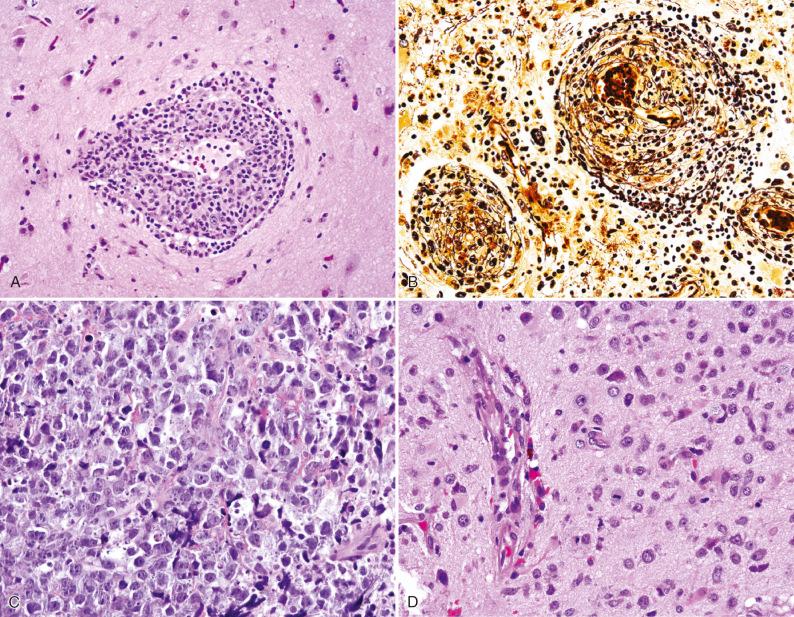
Intraoperative diagnosis of lymphoma can be difficult, and misdiagnosis of lymphoma is one of the most common errors in frozen section evaluation of CNS lesions. Misinterpretation at frozen section is often due to tumor cell nuclei appearing larger and more pleomorphic than in paraffin sections, smear artifacts giving a false impression of glial processes, and a lack of typical perivascular arrangements in small specimens ( Fig. 17.3A ). Features that favor the diagnosis of lymphoma over malignant glioma include the presence of abundant apoptotic nuclei, intermixed small (reactive) lymphocytes, stellate astrocytes of typical “reactive” morphology, and the absence of microvascular proliferation and palisading necrosis that are often seen in glioblastomas. In that respect, cytologic preparations (e.g., intraoperative smears) are often superior to frozen sections in demonstrating the predominance of large, discohesive cells with prominent nucleoli ( Fig. 17.3B ). Unfortunately, the distinction of lymphoma from other brain tumors is one of the most important decisions in surgical neuropathology because PCNSL is not resected in many centers and a frozen section diagnosis of lymphoma usually aborts further surgery in order to avoid the risk of neurologic damage.
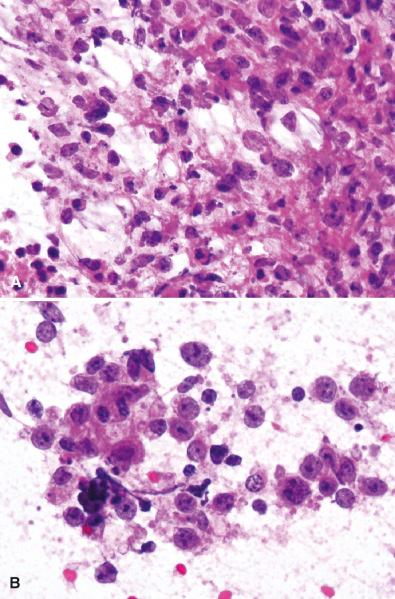
Diagnostic problems may also arise in DLBCL with atypical features, such as absence of CD45 expression, a proliferation index of less than 70%, or marked predominance of reactive T cells with only rare neoplastic B cells (“T cell–rich B cell lymphoma”). This latter scenario is particularly common, especially if the patient was treated with steroids prior to biopsy. All of these features may occur in DLBCL of the CNS, but the diagnosis has to be carefully reconsidered and confirmed by immunohistochemistry (see Ancillary Diagnostic Studies section).
In principle, any type of nodal lymphoma may also occasionally arise primarily in the CNS. The most common lymphoma types are listed in Box 17.1 and discussed in greater detail in the following sections. Various other lymphoma types have been described as case reports or in small case series, including Hodgkin disease, small lymphocytic lymphoma, B cell chronic lymphocytic leukemia with intracerebral transformation into DLBCL (Richter syndrome), Burkitt lymphoma, precursor B cell lymphoma, plasmablastic lymphoma, T cell lymphoblastic lymphoma, and extranodal nasal type T/NK cell lymphoma.
These tumors are highly aggressive B cell lymphomas, most of them corresponding to DLBCL. Compared with PCNSL in immunocompetent patients, they are more commonly multifocal and largely necrotic ( Fig. 17.4A ). The Epstein-Barr virus (EBV) is pathogenetically involved in virtually all cases, which is diagnostically useful because the EBV genome or protein can be demonstrated by in situ hybridization (ISH), immunocytochemistry, or polymerase chain reaction (PCR) in biopsy specimens or cerebrospinal fluid (CSF; Fig. 17.4B ). The underlying immunodeficiency is usually related to AIDS or post-transplant states, or more rarely to primary immunodeficiency disorders, but elderly patients treated with immunosuppressive drugs for various autoimmune disorders have also been described. Morphologic features identified in post-transplant cases include a monomorphic DLBCL pattern and a T cell–rich pattern, the monomorphic pattern being more likely to be myc immunonegative and CD30 positive.
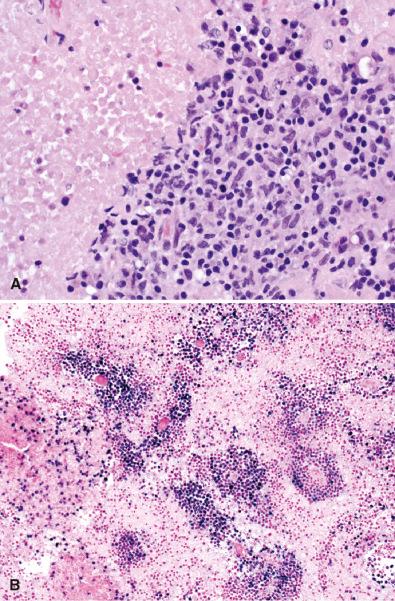
Lymphomatoid granulomatosis is a highly malignant B cell lymphoma with a characteristic angiocentric and angiodestructive growth pattern, leading to ill-defined lymphohistiocytic nodules (but not well-formed granulomas) and brain infarcts ( Fig. 17.5A ). Although polymorphic B cells represent the neoplastic cells, reactive cells predominate, including T cells, plasma cells, and macrophages ( Fig. 17.5B ). Neutrophils and eosinophils may also be encountered. EBV-positive B cells express CD20 and variably CD30 ( Fig. 17.5C and D ). Patients are usually immunosuppressed, although this may be detected only after careful clinical or laboratory analysis. Accordingly, the neoplastic process is driven by EBV, as in other immunodeficiency-associated lymphomas. Some tumors evolve to EBV-positive DLBCL. Monoclonal rearrangement of immunoglobulin genes is evident. Histologic distinction from other cases of immunodeficiency-associated lymphoma is vague and subjective. In fact, general pathologists who are not so familiar with the typical angiocentric pattern of any lymphoid lesion within the brain tend to be more inclined to making the diagnosis of intracerebral lymphomatoid granulomatosis as compared to neuropathologists. Lymphomatoid granulomatosis is usually a systemic disease, with 90% of patients showing lung involvement and 25% brain involvement, but primary CNS manifestation may occur.
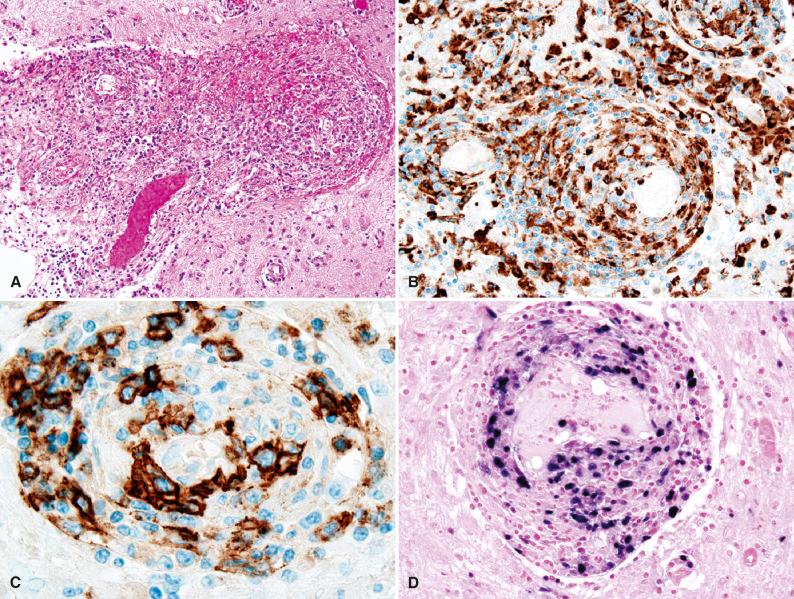
This extremely aggressive lymphoma type, once incorrectly referred to as “neoplastic angioendotheliomatosis,” is an extranodal DLBCL (very rarely T cell lymphoma) characterized by lymphoma cells present entirely or almost entirely within the lumina of small vessels, particularly capillaries ( Fig. 17.6 ). About 30% of patients present with CNS symptoms, and 65% show neurologic symptoms as the main manifestation of the disease course, despite involvement of several other organs. Vascular occlusion by tumor cells leads to infarcts. A defect in homing receptors preventing extravasation of tumor cells has been postulated. Even today, the diagnosis is often only made at autopsy, since the clinical presentation is often clinically confusing. However, it is occasionally encountered at the time of biopsy, and the diagnosis is easily missed without special attention to the intravascular cellular composition.
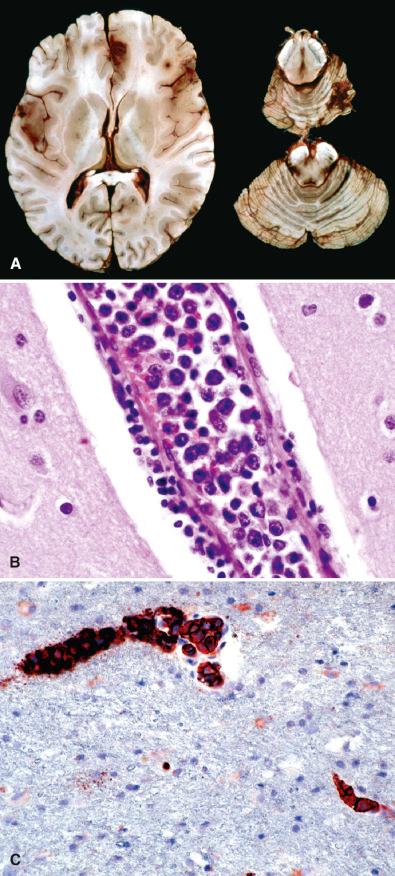
These tumors, also referred to as low-grade B cell lymphomas of mucosa-associated lymphoid tissue (MALT) type, are single or multiple extra-axial masses occurring in middle-aged patients with a female predilection. They enhance diffusely and radiologically mimic meningioma ( Fig. 17.7A ), due to their frequent involvement of dura and leptomeninges ( Fig. 17.7B ). They respond well to local therapy such as surgery and radiation treatment, with 3-year progression-free survival of 89%, demonstrating that MALT lymphoma of the dura is an indolent tumor with long survival. Tumor cells have small, moderately irregular, centrally located nuclei (resembling centrocytes) and often clear cytoplasm, sometimes referred to as “monocytoid B cells” ( Fig. 17.7C ). There is variable plasmacytic differentiation, and when prominent, the differential diagnosis may include IgG4-related disease. In contrast to other types of intracranial lymphoma, lymphoid follicles may be encountered, but are often immature or poorly formed. The typical immunophenotype shows positivity for CD20 ( Fig. 17.7D ) and Bcl-2; negativity for CD5, CD10, and CD21; and presence of light chain restriction. As in other B cell lymphomas, reactive T cells are also common ( Fig. 17.7E ).
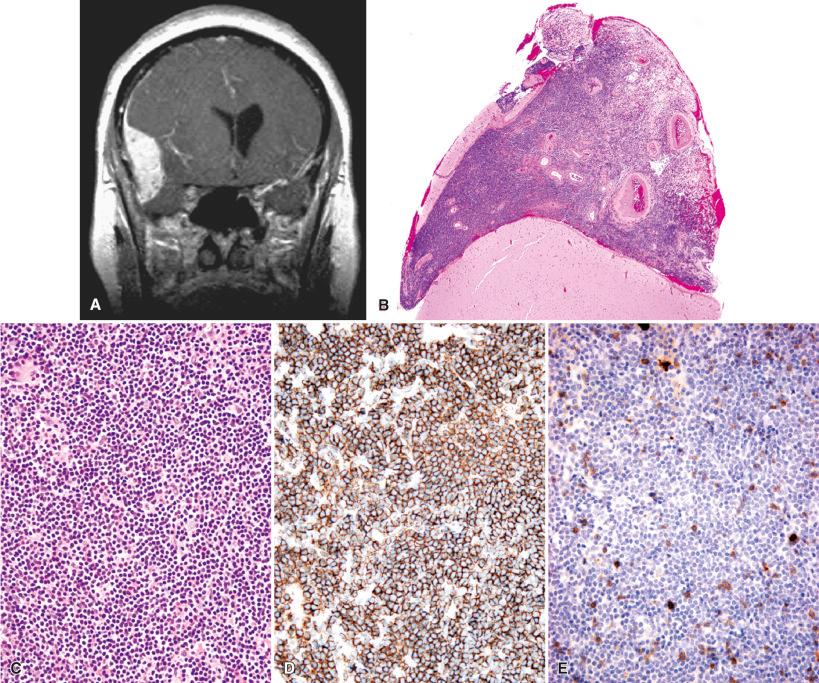
Become a Clinical Tree membership for Full access and enjoy Unlimited articles
If you are a member. Log in here